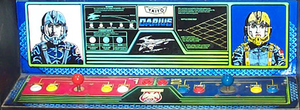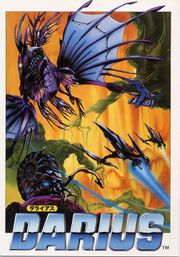Lost In Translation/Darius
| Darius | |
|---|---|
| Manufacturer | Taito Corporation Japan |
| Released | 1986 |
| Control Method |
8-way Joystick 2 Button(s) |
| Main CPU | (3x) 68000 (@ 8.000 MHz) Z80 (@ 4.000 MHz) |
| Sound CPU | Stereo (2x) YM2203 (@ 4.000 MHz) MSM5205 (@ 384.000 kHz) (18x) Volume Filter |
| Video Details |
Raster (Horizontal) 288 x 224 pixels 60.00 Hz 8,192 Palette colours |
| Screens | 3 |
| ROM Info | 35 ROMs 2,001,920 bytes (1.91 MiB) |
| MAME ID | darius · dariuse · dariusj · dariuso |
About The Game
Darius is an horizontally scrolling shoot-em-up and was one of the first arcade games to use a 3-screen display. The actual resolution of the game is 3x(288x224) or 864x224 giving a very long horizontal display, hence some of the conversions opting to display the game in the widescreen format.
In the game, the player flies an ornate fighter craft called a Silver Hawk. The craft is equipped with 2 attack weapons : Missile (forward-firing standard gun) and Bomb (drops from the bottom of the ship). The Silver Hawk is also equipped with the 'Arm' (armor); a green energy shield that can absorb enemy attacks without harm to the ship.
During the course of the levels the player must navigate the terrain and battle a variety of fighter craft, ground vehicles, turrets, and other obstacles. At the end of every level, players are greeted with the obligatory end-of-level boss. The bosses in Darius are often in the form of mechanical aquatic animals, such as fish or squid. If the player defeats the boss, the tunnel splits into two and the player must decide whether to take the upper or lower tunnel, both of which lead to a different stage. This allows many different paths to be taken through the game.
Power-ups can be obtained by shooting enemies of a certain color, with the power-ups appearing in the form of colored bubbles. Each color corresponds to one of the ship's three weapons :
- Red - Missile
- Green - Bomb
- Blue - Arm
If the player powers up a weapon more than seven times, the weapon changes to a new, more powerful version. This then becomes the player's default weapon, and can be powered up further. There are also two other colors of power-up bubble, white and orange; which can be obtained by shooting at certain sections of the terrain; unfortunately, there are no visual clues as to where these may be on any given level. These hidden power-ups offer the following :
- White - Gives a score bonus.
- Orange - Smart bomb that kills all on-screen enemies.
Trivia
Darius was unique in the fledgling genre for having a game screen three times longer than the usual size, and thus requiring three screens to be arranged side-by-side in order to play.
The player flies a small spacecraft called a Silver Hawk, which is also distinctive in being highly detailed in design - indeed, Taito devised mock blueprints for it. The Silver Hawks are a trademark of the series.
Another trademark of the series is the unique branching level structure. The levels are arranged in a large binary tree, and at the end of each level, the player must choose one of 2 paths to follow. This means that there are many different paths that can be taken through the game.
The heroes' names in Darius series 'PROCO' and 'TIAT' backwards spell 'TAITO CORP'.
The first stage music is a remix of the "Metal Soldier Isaac II" intro music (1985).
Pony Canyon / Scitron released a limited-edition soundtrack album for this game (Darius - PCCB-00093) on 21/08/1992.
Zuntata Records released a limited-edition soundtrack album for this game (Zuntata History L'ab-normal 1st - ZTTL-0038) on 01/04/1999.
Tips And Tricks
Progression Of The Bubbles
- Weapons (red) : Bullets --> Lasers --> Wave
- Shields (blue) : Green --> Silver --> Gold
- Bombs (green) : Single --> Dual --> Quad
Miscellaneous Bubbles
- Points (grey): Points
- Extra-ship : Bomb certain key spots on the terrain.
Power Levels And Weapons
There are 8 power levels (0-7) within each armament category.Your weapons, shields, and bombs improve as you go from 0-7 :
- The shots move faster and therefore recharge more quickly.
- Bullets increase in number and waves increase in height, thus destroying more enemies at once. Waves, once fired, will go through anything until leaving the screen to the right.
- Shields : They just recharge, but the better classes of shields absorb more hits. Gold shields will also protect your ship from collisions with objects as well as shots, but on certain screens that have lots of little squeezeways, gold shields can actually kill you by ricocheting your ship back and forth until you die.
- Bombs : They get 'smarter' in seeking out targets.
How to complete the game
- Completing the game is easiest with triple bullets.
- Explore the different paths this way, and when you're ready for a challenge, try to get wave.
- Lasers are not weapons so much as a handicap you have to endure while building to wave.
- Recommended paths (easiest) : A-C-E-H-M-R-X
Series
- Darius (1986)
- Darius II (1989)
- Darius Twin (1991, Nintendo Super Famicom)
- Darius Force (1993, Nintendo Super Famicom)
- Darius Gaiden - Silver Hawk (1994)
- G-Darius (1997)
- G-Darius ver.2 (1997)
Staff
- Directed And Produced By
- Toshio Kohno
- Game Designers
- Toshio Konho
- Akira Fujita
- Kazuya Mikata
- Programmers
- Ken Hasegama
- Takashi Kuriyama
- Hideaki Tomioka
- Tohru Sugawara
- Hidenori Sasatani
- Hideki Hashimoto
- Art Designers
- Tetsuroh Kitagawa
- Yoshihiro Wakita
- Junji Yarita
- Yukio Ishikawa
- Kohzoh Igarashi
- Genya Kuriki
- Taira Sanuki
- Masami Kikuchi
- Mitsuru Ogama
- Mechanical Engineers
- Takeki Nakamura
- Eiji Kubota
- Cabinet Designers
- Takeo Shiraishi
- Hisayoshi Nakane
- Natuki Hirosawa
- Hardware Designers
- Takashi Ohhada
- Syuji Kubota
- Seigo Sakamoto
- Music Composers
- Yasuhiko Tanaka
- Hisayoshi Ogura
- Naoto Yagishita
- Tsukasa Nakamura
- Eikichi Takahashi
- Masahiko Takaki
Cabinet and Artwork
Ports

- Consoles
- NEC PC-Engine ("Darius Alpha")
- NEC PC-Engine CD ("Super Darius")
- Sega Master System
- Sega Mega Drive ("Sagaia")
- Nintendo Game Boy Advance ("Darius R")
- Computers
- Atari ST (1989)
- Commodore Amiga ("Darius+", 1989, The Edge)
- Sinclair ZX Spectrum (1990, "Darius+")
- Sharp X68000
Soundtrack Releases
| Album Name | Catalogue No. | Released | Publisher | Comments |
|---|---|---|---|---|
| Game Music Festival ~Super Live '92~ | PCCB-00099[1] | 1992-10-21 | Pony Canyon, Inc. | CD version. |
| Zuntata Live '90 -G.S.M. Taito- | PCCB-00045[2] | 1990-10-21 | Pony Canyon/Scitron | CD version. |
| Darius the Omnibus -Generation- | ZTTL-0008[3] | 1997-03-28 | Zuntata Records | CD version. |
| Darius | PCCB-00093[4] | 1992-08-21 | Pony Canyon Inc. | CD version. |
| Zuntata Live 1997 -Cineteque Rave- (Visual File) | ZTTV-0001[5] | 1997-11-21 | Zuntata Records | Released on VHS. |
| ZUNTATA LIVE 1998 "güten Talk" from the earth ~AUDIO FILE~ | ZTTL-0031[6] | 1998-10-21 | Zuntata Records | 2 CD version. |
| ZUNTATA LIVE 1998 "güten Talk" from the earth ~VISUAL FILE~ | N/A[7] | 1998-11-10 | Zuntata Records | Released on VHS. |
| ZUNTATA HISTORY L'ab-normal 1st | ZTTL-0038[8] | 1999-04-01 | Zuntata Records | CD version. |
| THE VERY BEST OF OGR GALLERy ~Concepts~ | ZTTL-0049[9] | 1999-12-18 | Zuntata Records | 2 CD version. |
| THE VERY BEST OF Mar. GAME MUSIC II ~Dawn Chronicle~ | ZTTL-0053[10] | 2000-06-21 | Zuntata Records | CD version. |
| Darius Premium Box -Rebirth- | ZTMD-0001~5[11] | 2005-05-25 | Zuntata Records | 5 CD version. |
| Darius - TAITO GAME MUSIC VOL.2 | 28XA-166[12] | 1987-06-25 | Alfa Records | CD version. |
| Game Music Now & Then | SCDC-00292~3[13] | 2003-12-17 | Scitron Digital Content | 2 CD version. |
| Darius - TAITO GAME MUSIC VOL.2 | ALC-22912[14] | 1987-06-25 | Alfa Records | Cassette version. |
| Darius - TAITO GAME MUSIC VOL.2 | ALR-22912[15] | 1987-06-25 | Alfa Records | Vinyl version. |
| PC Engine's World of Darius | APCG-4001[16] | 1989-11-21 | APOLLON | CD version. |
| Darius Remix | SRIN-1037[17] | 2007-12-29 | Sweep Records | CD version. |
| Game Music Festival Live, Summer '93 ~OFFICIAL BOOTLEG CASSETTE~ | N/A[18] | 1993-01-01 | Pony Canyon/Scitron | Cassette version. |
| Scitron 10th Anniversary Special CD Sampler | DMCZ-300098[19] | 1998-01-01 | Scitron Label | 2 CD version. |
| Gaesen Oh - Scitron Game Music Mega Mix Vol.1 | KGCD-0001[20] | 1994-01-01 | Pony Canyon/Scitron | CD version. |
| Darius | ZTTL-9006[21] | 2007-10-29 | Zuntata Records | Digital download only. |
| TAITO GAME MUSIC | ZTTL-1003[22] | 2004-09-24 | Zuntata Records | CD version. |
| Beep Special Project - Video Game Music - Second Sono Sheet | N/A[23] | 1987-01-01 | Softbank Publishing | Vinyl version. |
Sound Comparison
| Platform | Song Titles | Sound Source | |||||||
|---|---|---|---|---|---|---|---|---|---|
| Arcade | "Captain Neo (Space Cave)" | "Boss 1" | "Round Clear" | "Inorganic Beat (City)" | "Boss 2" | "Cosmic Air Way (Mountain Region)" | "Boss 3" | "Choas -Main Theme- (Van Allen Belt)" | M1 v0.7.8a6 |
| Platform | Song Titles (Continued...) | Sound Source | |||||||
|---|---|---|---|---|---|---|---|---|---|
| Arcade | "Boss 4" | "The Sea (Undersea Base)" | "Boss 5" | "Boss 6" | "Boss 7" | "Ending" | "Name" | "Over" | M1 v0.7.8a6 |
External Links
- Sinclair ZX Spectrum version of Darius+ at the World of Spectrum
References
- ↑ Game Music Festival ~Super Live '92~ (CD) at the VGMdb
- ↑ Zuntata Live '90 -G.S.M. Taito- (CD) at the VGMdb
- ↑ Darius the Omnibus -Generation- (CD) at the VGMdb
- ↑ Darius (CD) at the VGMdb
- ↑ Zuntata Live 1997 -Cineteque Rave- (Visual File) (VHS) at the VGMdb
- ↑ ZUNTATA LIVE 1998 "güten Talk" from the earth ~AUDIO FILE~ (CD) at the VGMdb
- ↑ ZUNTATA LIVE 1998 "güten Talk" from the earth ~VISUAL FILE~ (VHS) at the VGMdb
- ↑ ZUNTATA HISTORY L'ab-normal 1st (CD) at the VGMdb
- ↑ THE VERY BEST OF OGR GALLERy ~Concepts~ (CD) at the VGMdb
- ↑ THE VERY BEST OF Mar. GAME MUSIC II ~Dawn Chronicle~ (CD) at the VGMdb
- ↑ Darius Premium Box -Rebirth- (CD) at the VGMdb
- ↑ Darius - TAITO GAME MUSIC VOL.2 (CD) at the VGMdb
- ↑ Game Music Now & Then (CD) at the VGMdb
- ↑ Darius - TAITO GAME MUSIC VOL.2 (Cassette) at the VGMdb
- ↑ Darius - TAITO GAME MUSIC VOL.2 (Vinyl) at the VGMdb
- ↑ PC Engine's World of Darius (CD) at the VGMdb
- ↑ Darius Remix (CD) at the VGMdb
- ↑ Game Music Festival Live, Summer '93 ~OFFICIAL BOOTLEG CASSETTE~ (Cassette) at the VGMdb
- ↑ Scitron 10th Anniversary Special CD Sampler (CD) at the VGMdb
- ↑ Gaesen Oh - Scitron Game Music Mega Mix Vol.1 (CD) at the VGMdb
- ↑ Darius (Digital Download) at the VGMdb
- ↑ TAITO GAME MUSIC (CD) at the VGMdb
- ↑ Beep Special Project - Video Game Music - Second Sono Sheet (Vinyl) at the VGMdb







